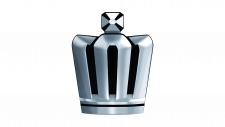Dacia Logo
Dacia, a Romanian automobile manufacturer, is renowned for its budget-friendly cars. Established in 1966, it became a subsidiary of the French carmaker Renault in 1999. Dacia has gained popularity in Europe and beyond for its cost-effective, reliable vehicles. The brand focuses on the European market, particularly in Eastern Europe, but its models like the Duster and Sandero have found success in various international markets. Dacia’s approach emphasizes simplicity and functionality, offering essential features without luxury add-ons, making it a go-to choice for consumers seeking affordability and practicality.
Meaning and history
Founded in 1966 in Romania, Dacia embarked on its automotive journey with an initial collaboration with the French automaker Renault. This alliance allowed Dacia to produce Renault’s designs, notably launching with the Dacia 1100, a rebranded version of the Renault 8. The brand’s early years were marked by the Dacia 1300, introduced in 1969, a model that would become emblematic of the brand and remain in production in various incarnations for over three decades.
The late 20th century, particularly the 1980s and 1990s, presented a turbulent period for Dacia. The fall of communism in Romania and the shift towards a market economy in the 1990s brought significant challenges. During this era, Dacia faced the dual hurdles of outdated technology and increasing competition from more modern, international car manufacturers.
The new millennium brought a resurgence for Dacia, beginning with Renault’s acquisition of a controlling stake in 1999. This was a pivotal moment, marking a rejuvenation of the brand through Renault’s infusion of contemporary design and manufacturing expertise. A landmark in this rejuvenation was the introduction of the Dacia Logan in 2004. Designed as an affordable yet robust car for emerging markets, the Logan’s success heralded Dacia’s entry into European markets and beyond.
The brand’s portfolio expanded with the addition of models like the Sandero, a practical hatchback, and the Duster, an economical SUV. These models were acclaimed for their blend of basic functionality, reliability, and affordability, encapsulating Dacia’s philosophy of providing essential automotive features without the premium cost.
In recent times, Dacia has navigated the evolving automotive landscape, placing an emphasis on eco-friendly vehicles. The brand has been working to integrate more sustainable technologies while maintaining its core principles of simplicity and cost-effectiveness, particularly in light of the automotive industry’s gradual shift towards electric and hybrid vehicles.
Throughout its history, Dacia has transformed from a regional car manufacturer into a notable player in the global automotive market. This transformation has been underpinned by its enduring collaboration with Renault, with the brand consistently symbolizing practical and affordable mobility solutions.
What is Dacia?
Dacia is a Romanian car manufacturer, distinguished for producing affordable and practical vehicles. Established in 1966 and revitalized under Renault’s ownership since 1999, it has gained a reputation for offering reliable, no-frills cars, catering primarily to budget-conscious consumers. The brand’s focus on functionality over luxury has made it a popular choice in various global markets.
1966 – 1978
The logo features a bold eagle in gold, wings outstretched, poised above a mountain range. The eagle, a symbol of freedom and height, is centered on a shield, outlined in black with a light blue background, conveying stability and trust. Resting atop the shield, a black banner with the acronym “UAP” stands out in stark, white letters, suggesting a strong, formal association. The mountains, capped with white, suggest resilience and natural strength, while the green base indicates growth and vitality. This emblem, with its commanding eagle and striking colors, embodies a sense of power, tradition, and ambition.
1978 – 1990
This monochromatic logo presents a striking, embossed eagle, wings unfurled, in a poised stance above rugged mountains. It’s encased in a shield-shaped emblem, outlined with a subtle gleam, suggesting a metallic texture. The eagle’s detailed plumage and determined gaze evoke strength and precision, while the mountains, less detailed than in the previous logo, now have a stylized appearance, emphasizing resilience. Above the eagle, the block lettering “UAP” is embedded in a thick, horizontal banner, providing a pronounced contrast to the textured imagery below. This iteration of the emblem opts for grayscale tones, giving it a classic, timeless quality, distinct from the previous version’s vibrant color scheme. The shift to grayscale imbues the logo with a more formal, sophisticated character, reflecting a mature identity.
1980 – 1997
This logo casts aside imagery for stark, bold lettering, spelling “DACIA” in strong, white, uppercase fonts against a black shield. The design is minimalist, focusing entirely on the brand’s name without the embellishment of an eagle or mountains, marking a significant departure from previous logos. The shield, a classic symbol of protection and strength, is outlined with a white border, enhancing its prominence. This design choice reflects a modern, no-nonsense approach, projecting the brand’s confidence purely through its name. The simplicity of the design suggests a universal appeal, emphasizing clarity and recognizability in a move that starkly contrasts the earlier, more ornate logo designs.
1997 – 2002

2002 – 2008
The logo evolves into a dynamic design, with the “DACIA” name now superimposed over a pattern of rising blue triangles within the shield, suggesting a forward-moving momentum. The triangles, reminiscent of peaks or arrows, create a sense of upward progression and innovation. This textured backdrop provides depth, contrasting with the previous logo’s solid color, and signifies a shift towards a more modern and dynamic brand identity. The surrounding silver outline adds a refined touch, framing the logo with a sleek, contemporary feel. This logo retains the familiar shield shape, a consistent symbol of the brand’s resilience and strength. The new design elements reflect a brand looking towards the future, embracing change and movement.
2008 – 2015
The logo showcases a dramatic evolution, abandoning the traditional shield for a modern, stylized ‘D’ shape, signifying a leap into contemporary branding. The name “DACIA” is inscribed in a clean, sans-serif typeface, floating above a gradient of silver and gray, which imparts a metallic, sleek finish. This design marks a stark contrast from the previous triangular pattern, opting instead for a fluid, chrome-like appearance that reflects sophistication and modernity. The use of gradient and the contouring around the ‘D’ create an illusion of depth and dimension, positioning the brand as forward-thinking and adaptable. This logo encapsulates a departure from a historic emblem towards a futuristic and minimalist aesthetic, aligning Dacia with a new age of automotive design.
2015 – 2021
This iteration of the logo maintains the stylized ‘D’ silhouette but refines it with deeper contrasts and shading, accentuating its three-dimensional aspect. “DACIA” remains prominently displayed, now with a shadow effect that adds depth and prominence to the lettering. The gradient within the ‘D’ shifts from a linear to a radial pattern, creating a focal point that draws the eye inward. This subtle yet sophisticated change suggests a lens or aperture, symbolizing focus and clarity in the brand’s vision. The outer rim of the ‘D’ features a gradient transition from black to silver, giving the logo a polished, metallic edge. These refinements in shading and texture convey a sense of evolution and refinement in the brand’s identity, emphasizing a sleek and modern aesthetic.
2020 – 2021
The logo presents a marked shift towards minimalism, featuring the word “DACIA” in a plain, navy blue font against a clean background. This design strips away the previous emblem’s gradients and metallic finishes, favoring a straightforward, flat color and sans-serif typeface. The elimination of graphic elements signifies a modern, unfussy approach, focusing solely on the brand name. The choice of navy blue represents dependability and professionalism. This refreshed identity is a stark contrast to the prior design’s three-dimensional effects, symbolizing a new chapter of simplicity and clarity for Dacia. The brand’s evolution is reflective of contemporary design trends that value minimalism and directness.
2021 – Today
The logo depicts the brand name “DACIA” in a bold, geometric typeface that introduces a modern and abstract style. The letters are transformed into sharp, angular shapes that play with negative space, creating a striking visual effect. Above the name, the stylized ‘DC’ monogram, constructed of mirrored chevrons, commands attention. This design is a departure from the previous logo’s conventional lettering, embracing an edgier and more futuristic look. The monochromatic color scheme is straightforward yet powerful, emphasizing the contemporary edge of the brand. This logo moves away from minimalism, bringing in a sophisticated, cryptic element that challenges traditional design and represents the brand’s innovative direction.



















